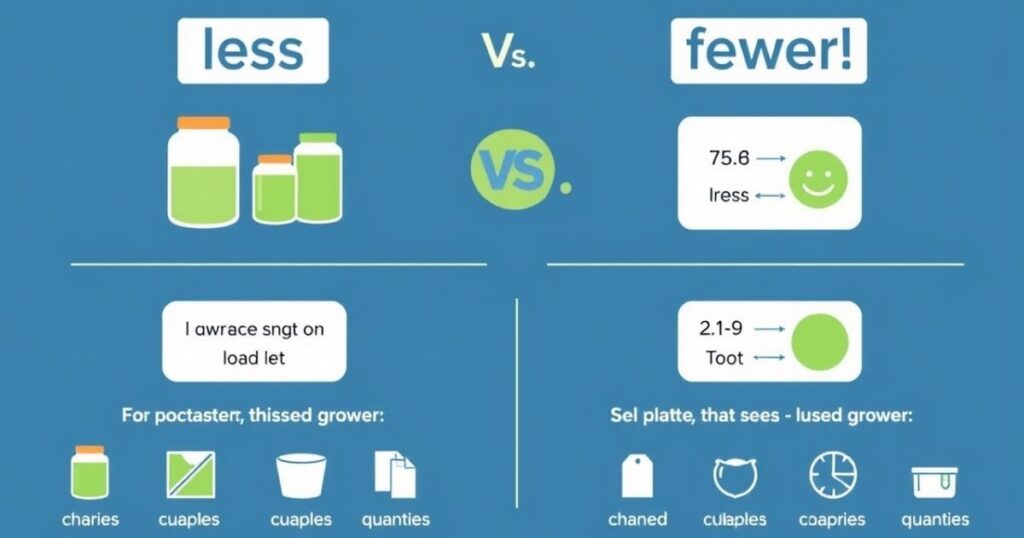The phrase “Ten Items or Less” is commonly seen on signs in stores, but it actually contains a ten items or less error in its grammar. The issue lies in the misuse of the word “less,” which is incorrect when referring to countable items. According to proper ten items or less grammar, the correct phrase should be “Ten Items or Fewer”, since “items” are countable. This small mistake is often overlooked but can cause confusion for those who care about precise language use. It’s crucial to understand the distinction between “ten items or less” and “ten items or fewer” for clearer communication.
In terms of 10 items or less grammar, the distinction between “less” and “fewer” becomes especially important. While many people use the phrase “Ten Items or Less” casually, it’s grammatically inaccurate. The 10 items or fewer form is the correct choice when referring to countable nouns like items. By adopting “ten items or fewer”, you ensure you’re following proper grammar rules and correcting the ten items or less error.
Understanding Countable and Uncountable Nouns
In English grammar, nouns are categorized as countable or uncountable, which affects their usage in sentences. Knowing the difference helps in using the correct articles, quantifiers, and verbs.
1. Countable Nouns
Countable nouns refer to things that can be counted individually. They have singular and plural forms.
Examples:
- Singular: apple, book, chair, idea
- Plural: apples, books, chairs, ideas
Key Rules:
- Use a/an with singular countable nouns (a chair, an apple).
- Use numbers or quantifiers like some, many, few with plural forms (three books, a few ideas).
2. Uncountable Nouns
Uncountable nouns refer to things that cannot be counted separately because they exist as a mass or an abstract concept. These nouns do not have a plural form.
Examples:
- Liquids: water, milk, juice
- Substances: sugar, salt, flour
- Abstract concepts: happiness, information, advice
- Natural phenomena: weather, air, sunlight
Key Rules:
- Do not use a/an with uncountable nouns (a sugar and an information are incorrect).
- Use some, much, a little, a lot of instead of numbers (some rice, much happiness).
3. Special Cases
Some nouns can be both countable and uncountable, depending on their meaning.
Examples:
- Paper (uncountable: material) → I need some paper.
- A paper (countable: a newspaper) → I read a paper every morning.
- Chicken (uncountable: food) → I love eating chicken.
- A chicken (countable: animal) → We have three chickens in the yard.
4. Expressions with Uncountable Nouns
Since uncountable nouns do not have plural forms, specific measurements are used to quantify them:
- A piece of advice (not an advice)
- A glass of water (not a water)
- A loaf of bread (not a bread)
The Rules for Using Less and Fewer

The distinction between less and fewer follows a simple rule:
● Use fewer with countable nouns: Fewer apples, fewer cars, fewer items.
● Use less with uncountable nouns: Less water, less rice, less information.
Knowing these guidelines, the grocery shop sign ought to say Ten Items or Fewer, since items are measurable. This grammar rule is broken and usage of the word less in this context is improper.
Common Misunderstandings and Misuses
The misuse of less instead of fewer is widespread and often goes unnoticed in everyday language. This misuse has become so common that many people do not recognize it as an error.
Examples of Incorrect Usage:
● Less calories instead of fewer calories
● Less people instead of fewer people
● Less mistakes instead of fewer mistakes
These phrases are incorrect because calories, people, and mistakes are all countable nouns. The correct word in these cases should be fewer.
1. Standard Definition
Explanation: “Less” is used with uncountable nouns, while “fewer” is reserved for countable nouns.
Example:
- Correct: “You have less water in your bottle.” (Water is uncountable.)
- Correct: “You have fewer bottles of water.” (Bottles are countable.)
2. Countable vs. Uncountable
Explanation: Items in a shopping context can be counted individually (e.g., apples, cans).
Example:
- Correct: “You can take fewer apples.” (Apples are countable.)
3. Grammatical Rule
Explanation: The general grammatical rule dictates the use of “fewer” for countable items.
Example:
- Correct: “There are fewer students in this class than in that one.”
4. Common Misuse
Explanation: “Less” has become a common misuse in phrases where “fewer” should be employed.
Example:
- Incorrect: “10 Items or Less”
- Correct: “10 Items or Fewer“
Many grocery stores still use “10 Items or Less,” making it a widely accepted but grammatically incorrect phrase.
5. Importance of Precision
Explanation: Correct usage enhances clarity in communication, particularly in writing.
Example:
- Ambiguous: “We have less sugar.” (Unclear about quantity.)
- Clearer: “We have fewer than five bags of sugar.” (Specifies quantity.)
6. Less with Singular, Fewer with Plural
Explanation: “Less” is used with singular nouns, while “fewer” is used with plural nouns.
Example:
- Correct: “Less traffic on the roads.”
- Correct: “Fewer cars on the road.”
7. Less with Abstract Concepts
Explanation: “Less” is used for things that cannot be counted individually, like emotions or qualities.
Example:
- Correct: “Less patience leads to more frustration.”
8. Fewer with Groups of Things
Explanation: If something consists of individual units, use “fewer.”
Example:
- Correct: “Fewer grains of sand are in this jar.”
9. Less with Time and Distance
Explanation: “Less” is used when referring to time, distance, and amounts.
Example:
- Correct: “We have less than five minutes left.”
- Correct: “The destination is less than three miles away.”
10. Fewer with Specific Quantities
Explanation: If an exact number of countable items is mentioned, use “fewer.”
Example:
- Correct: “Fewer than ten students passed the test.”
11. Less with Money and Percentages
Explanation: Even though money and percentages involve numbers, “less” is used because they represent an overall amount.
Example:
- Correct: “He spent less than $50 on dinner.”
- Correct: “Less than 20% of people agreed with the statement.”
12. Fewer with Individual Units
Explanation: If something is counted as separate units, use “fewer.”
Example:
- Correct: “Fewer slices of bread were left.”
13. Less with Unmeasurable Substances
Explanation: If something cannot be divided into separate units, use “less.”
Example:
- Correct: “Less salt is needed for this recipe.”
14. The “Ten Items or Less” Debate
Explanation: Although “fewer” is correct, “less” has become widely accepted in casual usage.
Example:
- Technically Correct: “Ten Items or Fewer”
- Common but Incorrect: “Ten Items or Less”
15. Avoiding the Mistake in Formal Writing
Explanation: While “less” is often misused in speech, formal writing should follow grammar rules.
Example:
- Correct: “Fewer people attended the conference this year.”
16. Less with Statistical Comparisons
Explanation: “Less” is often used when discussing general trends or percentages.
Example:
- Correct: “Less than half of the respondents agreed.”
17. The Role of Context in Choosing “Less” or “Fewer”
Explanation: Consider the meaning behind your words before choosing “less” or “fewer.”
Example:
- Correct: “Fewer tourists visited the city this year.”
- Correct: “There was less tourism overall.”
18. Fewer with Specific Objects
Explanation: Use “fewer” when referring to concrete, countable objects.
Example:
- Correct: “Fewer chairs were available for guests.”
19. Less with Singular Collective Nouns
Explanation: “Less” applies to collective nouns, even if they represent multiple things.
Example:
- Correct: “Less furniture was needed in the new office.”
20. Fewer with Plural Countable Items
Explanation: If the noun is plural and countable, use “fewer.”
Example:
- Correct: “Fewer employees attended the meeting.”
21. Less with Non Specific Quantities
Explanation: If the amount is vague and uncountable, use “less.”
Example:
- Correct: “We have less space for storage now.”
Related Guide:
Top 30 most used words with suffix less
22. Fewer with Explicitly Countable Groups
Explanation: If an exact number can be assigned, use “fewer.”
Example:
- Correct: “Fewer pencils were left in the box.”
23. Less with Bulk Purchases
Explanation: When discussing bulk goods as a whole, use “less.”
Example:
- Correct: “We need less rice for this dish.”
24. Fewer with Individual Units of a Bulk Good
Explanation: If referring to separate units of a bulk good, use “fewer.”
Example:
- Correct: “Fewer bags of rice were sold today.”
25. Less with Statistical Trends
Explanation: Use “less” when referring to general statistical trends.
Example:
- Correct: “Less crime has been reported this year.”
26. Fewer with Individual Crime Cases
Explanation: If referring to distinct instances, use “fewer.”
Example:
- Correct: “Fewer robberies occurred this year.”
27. Less with Time Spans
Explanation: Use “less” when discussing a duration of time.
Example:
- Correct: “I spent less than two hours on the project.”
28. Fewer with Countable Time Periods
Explanation: If referring to countable units of time, use “fewer.”
Example:
- Correct: “Fewer days were required to complete the task.”
29. Less with Distance and Measurements
Explanation: Use “less” when discussing distance, weight, or volume.
Example:
- Correct: “The lake is less than five miles away.”
30. Fewer with Physical Countable Objects
Explanation: Use “fewer” when referring to objects measured individually.
Example:
- Correct: “Fewer water bottles were used during the trip.”
31. Less with Abstract Measurements
Explanation: Use “less” when referring to abstract or conceptual measurements.
Example:
- Correct: “She showed less enthusiasm for the project.”
32. Fewer with Individual Bills or Coins
Explanation: If referring to specific countable units of money (bills or coins), use “fewer.”
Example:
- Correct: “Fewer quarters were collected today.”
33. Less with Speed and Efficiency
Explanation: Use “less” when talking about speed or efficiency since they are uncountable concepts.
Example:
- Correct: “The new system takes less time to load.”
34. Fewer with Number of Tasks
Explanation: If referring to separate, countable tasks, use “fewer.”
Example:
- Correct: “Fewer assignments were due this semester.”
35. Less with Weight and Mass
Explanation: Weight and mass are uncountable, so “less” is appropriate.
Example:
- Correct: “He weighs less than 150 pounds.”
36. Fewer with Countable Packaged Goods
Explanation: If referring to packaged goods counted individually, use “fewer.”
Example:
- Correct: “Fewer bottles of soda were sold today.”
37. Less with Degree or Intensity
Explanation: Use “less” when describing the degree of something.
Example:
- Correct: “This movie is less exciting than the first one.”
38. Fewer with Separate Instances of an Event
Explanation: If referring to individual, countable events, use “fewer.”
Example:
- Correct: “Fewer accidents happened on the highway this year.”
39. Less with General Consumption or Usage
Explanation: Use “less” when referring to overall consumption.
Example:
- Correct: “People are drinking less coffee these days.”
40. Fewer with Individual Servings of a Consumable
Explanation: If referring to countable servings or portions, use “fewer.”
Example:
- Correct: “Fewer cups of coffee were served this morning.”
Why the Distinction Matters
Understanding the difference between “less” and “fewer” improves communication and prevents common grammar mistakes. The phrase “Ten Items or Less” is grammatically incorrect because “items” are countable, making “fewer” the proper choice. While the misuse is widespread, maintaining grammatical accuracy ensures clarity in both everyday language and professional writing.
1. Clarity and Precision
Using proper grammar ensures clarity and precision in communication. The phrase “Ten Items or Less” is misleading because “items” are countable, and “fewer” should be used instead. Saying “Ten Items or Fewer” provides a clearer message and avoids confusion, making instructions more accurate.
2. Consistency in Language
Language rules should be applied consistently to maintain correctness. The incorrect phrase “Ten Items or Less” contradicts established grammatical rules. By consistently using “less” for uncountable nouns and “fewer” for countable ones, written and spoken communication remains uniform and professional.
3. Educational Standards
Grammar rules shape educational standards and influence how language is taught. Allowing phrases like “Ten Items or Less” reinforces incorrect usage and weakens grammar education. Teaching the distinction between “less” and “fewer” helps learners develop stronger language skills and better writing habits.
4. Professionalism
Correct grammar enhances professionalism in both business and formal settings. The phrase “Ten Items or Less” might be acceptable in casual speech, but in professional writing, it would be considered incorrect. Using “Ten Items or Fewer” demonstrates attention to detail and a commitment to accurate communication.
Historical Context and Evolution of Language
Language evolves over time, often bending grammar rules based on common usage. The phrase “Ten Items or Less” has become widely accepted despite being incorrect.
Historically, “less” was once used for countable nouns, but grammar rules later distinguished it from “fewer.” The phrase “Ten Items or Less” reflects how language shifts over time.
Old English texts show inconsistent use of “less” and “fewer,” proving that language is fluid. However, the phrase “Ten Items or Less” still contradicts modern grammar rules.
Dictionaries and style guides reinforce correct usage, yet marketing and signage influence public perception. This is why stores continue using “Ten Items or Less” despite its inaccuracy.
Over time, informal speech patterns have shaped grammar trends, making errors seem normal. The persistence of “Ten Items or Less” shows how frequent usage can override correctness.
Some grammarians argue that rigid rules should adapt to modern language habits. However, others insist that “Ten Items or Less” weakens grammatical precision.
Media and advertising often favor simplicity over correctness, spreading common errors. This explains why “Ten Items or Less” remains widely seen in supermarkets.
While language changes, maintaining grammatical distinctions preserves clarity and meaning. Correcting “Ten Items or Less” to “Ten Items or Fewer” aligns with proper English usage.
Correcting the Error
To correct the error in phrases like “Ten Items or Less”, simply replace “less” with “fewer” to align with grammatical rules. Here’s how to fix it:
- Identify Countable Nouns: Recognize that “items” are countable, so “fewer” is the appropriate choice.
- Apply the Rule: Change “Ten Items or Less” to “Ten Items or Fewer” to make it grammatically correct.
- Reinforce the Correction: Use this correction consistently in both spoken and written language to ensure clarity and precision.
The Role of Education in Addressing the Error
Education plays a vital role in correcting common grammar errors, including the misuse of “Ten Items or Less.” Teaching students the difference between countable and uncountable nouns helps them use language more accurately.
Through consistent instruction, educators can clarify the proper use of “fewer” for countable nouns like items, emphasizing that “Ten Items or Less” is incorrect. By addressing these common mistakes early, students are better equipped for clear communication.
Grammar education builds a foundation for effective writing, where phrases like “Ten Items or Fewer” align with proper standards. The classroom is an ideal space to instill these essential distinctions for lifelong language accuracy.
As students learn about proper noun usage, they begin to recognize and correct errors in daily language. The shift from saying “Ten Items or Less” to “Ten Items or Fewer” ensures consistency in written and spoken communication.
Educational programs that focus on grammar detail can improve how students express themselves professionally. Understanding the role of “fewer” enhances language proficiency, preventing common mistakes like “Ten Items or Less” in workplace communication.
Grammar instruction isn’t just about rules; it fosters critical thinking in students. Encouraging learners to question why “Ten Items or Less” is wrong helps them understand the nuances of language.
The distinction between “less” and “fewer” also influences how students interpret information. By teaching them to recognize when “Ten Items or Less” is incorrect, educators help students become more accurate in their everyday language use.
By focusing on these subtle but important grammar differences, education can make a lasting impact. Correcting “Ten Items or Less” strengthens writing and communication, preparing students for success in various fields.
The Influence of Media and Popular Culture

The misuse of “less” instead of “fewer” in phrases like “Ten Items or Less” is widely seen in media. Popular culture often perpetuates this incorrect usage without much correction, making it seem acceptable.
Television shows, advertisements, and movies often ignore grammar rules for the sake of simplicity. The phrase “Ten Items or Less” has even appeared in some of these contexts, reinforcing the error.
Media influence plays a significant role in how language evolves, sometimes leading to the acceptance of mistakes. The continuous use of “Ten Items or Less” in public spaces normalizes it, even though it is incorrect.
When seen on grocery store signs or commercials, “Ten Items or Less” can shape the way people think about grammar. As a result, individuals may unknowingly adopt this incorrect structure in their own speech and writing.
Popular culture often bends language rules for entertainment or convenience. However, “Ten Items or Less” is a clear example of how this trend can lead to widespread misunderstandings of grammar.
The phrase “Ten Items or Less” has been repeated so often in media that it feels natural to many. This consistency makes it more difficult for people to recognize the grammatical error behind it.
Social media platforms are a major driver in shaping language trends. When influencers or brands use “Ten Items or Less”, it can quickly spread to a larger audience, further normalizing the mistake.
The power of media and culture is undeniable when it comes to language trends. As “Ten Items or Less” continues to appear in popular culture, it becomes more challenging to correct the mistake in everyday language.
Practical Tips for Correct Usage
To ensure correct usage, always remember to use “fewer” with countable nouns and “less” with uncountable ones. For instance, “Ten Items or Fewer” is correct because “items” are countable, while “less” would be used for uncountable concepts like water or sugar. Keep this simple rule in mind for clearer, more precise communication.
1. Understand the Rule:
To avoid mistakes like “Ten Items or Less”, it’s crucial to understand the rule between countable and uncountable nouns. Knowing that “fewer” is used for countable items, like “items,” ensures proper grammar.
2. Practice Regularly:
Regular practice helps reinforce the correct usage of “fewer” instead of “less.” By consistently applying this in everyday conversations, including phrases like “Ten Items or Fewer”, you’ll improve your language skills.
3. Read and Listen:
Expose yourself to correct language usage by reading well-edited materials and listening to grammatically sound content. This will help you spot mistakes like “Ten Items or Less” and teach you how to properly use “fewer.”
4. Seek Feedback:
Ask for feedback from a trusted source to identify areas for improvement. If you’re uncertain about phrases like “Ten Items or Less,” a grammar expert can guide you to the proper usage of “fewer.”
5. Use Grammar Resources:
Make use of grammar resources, such as online guides or apps, to clarify language rules. These tools can be helpful when correcting errors like “Ten Items or Less” and ensuring your grammar is accurate.
Broader Implications of Proper Grammar
Proper grammar, such as using “Ten Items or Fewer” instead of “Ten Items or Less,” extends beyond just correct language use; it reflects a person’s attention to detail and credibility. In both personal and professional settings, mastering grammar helps ensure clear communication, fosters trust, and creates a more professional and respectful image.
1. Professional Communication
In professional communication, accuracy is crucial. Using the correct phrase “Ten Items or Fewer” rather than “Ten Items or Less” demonstrates attention to detail and improves the clarity of your message, reflecting well on your professionalism.
2. Academic Success
In academics, grammar matters. Understanding the distinction between “Ten Items or Fewer” and “Ten Items or Less” can significantly impact your writing quality, ensuring your work aligns with academic standards and earns higher marks for precision.
3. Social Perceptions

How we speak shapes how others perceive us. Using the correct grammar, like “Ten Items or Fewer”, shows that you are detail-oriented and well-educated, influencing how you are viewed in both personal and professional social contexts.
4. Preservation of Language:
Correct grammar usage, such as “Ten Items or Fewer”, plays a vital role in preserving the integrity of language. Here are four key points:
- Maintaining Accuracy: Using the right terms ensures clarity and prevents language from becoming confusing or diluted.
- Avoiding Language Decline: Consistent misuse of grammar leads to the gradual decline of proper language standards, affecting communication quality.
- Cultural Significance: Proper grammar reflects the cultural and historical richness of language, passing it accurately to future generations.
- Enhancing Communication: The preservation of language through correct usage ensures that ideas are conveyed clearly and effectively across all mediums.
FAQ’s
What makes the phrase grammatically incorrect?
The phrase commonly used in stores should be corrected. Ten Items or Less is wrong because “items” are countable, so “fewer” should be used instead.
Why should we avoid using “less” with countable nouns?
When referring to things we can count, Ten Items or Less becomes a grammar mistake. “Fewer” is the correct word to use in such cases.
What is the proper way to phrase the sign?
To follow grammatical rules, the sign should read Ten Items or Less. Using “fewer” ensures correct usage when talking about countable objects like items.
How does the error impact clear communication?
Using Ten Items or Less can confuse people about grammar. It’s important to use “fewer” to make sure your message is clear and accurate.
Is this mistake common in everyday language?
Yes, Ten Items or Less is widely used, but it’s still incorrect. People often overlook the difference between “less” and “fewer,” despite its grammatical impact.
Conclusion
The phrase “Ten Items or Less” contains a ten items or less error that can easily be corrected by using “Ten Items or Fewer” instead. This small grammar mistake is common, but it’s important to follow the rules of ten items or less grammar to communicate clearly and correctly. The confusion arises because “less” should only be used with uncountable nouns, while “fewer” is reserved for countable items, like “items.”
To avoid this ten items or less error, always opt for “Ten Items or Fewer” in contexts where you’re referring to countable things. Remember, understanding the difference between 10 items or less grammar and 10 items or fewer is crucial for maintaining proper language usage. Correcting this one error helps improve your communication and ensures that you’re using the right grammar in both written and spoken language.

Zion Blaze is a dedicated administrator with 5 years of experience in managing operations, optimizing workflows, and ensuring efficiency. Skilled in leadership, problem-solving, and team coordination.

